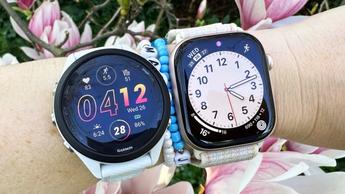Apple Watch 10 vs Garmin Forerunner 265: ¿qué pulsera de actividad cuenta los pasos con mayor precisión?
Comparativa directa revela cuál es el contador de pasos más preciso entre Apple y Garmin

¿Tienes curiosidad por saber qué smartwatch ofrece un seguimiento de pasos más preciso: el Apple Watch Series 10 o el Garmin Forerunner 265? Puse ambos dispositivos a prueba llevándolos en mis muñecas y contando manualmente mis pasos para ver cuál salía vencedor. Sigue leyendo para descubrir qué reloj registró mis pasos con mayor precisión.
Tras años comparando smartwatches, siempre empiezo comprobando cómo cada dispositivo cuenta los pasos. Cuando configuras uno de los mejores Apple Watch o los mejores Garmin, introduces tu altura y peso para que el reloj pueda estimar con precisión las calorías que quemas. Sin embargo, para el conteo de pasos, ambos relojes se basan en la detección del movimiento de tus brazos.
Cada vez que balanceas el brazo se cuentan dos pasos, y no importa si llevas el reloj en la mano dominante o en la no dominante: el sensor de movimiento integrado, llamado acelerómetro, mide tu movimiento.
He notado que actividades como empujar un carrito pueden dificultar que algunos relojes detecten los pasos, ya que el movimiento del brazo es limitado. Para que la prueba fuera justa y precisa, dejé el carrito en casa. En esta comparación, llevé el Apple Watch Series 10 en la muñeca izquierda y el Garmin Forerunner 265 en la derecha, asegurándome de que ambos tuvieran la mejor oportunidad de registrar cada paso.
He caminado 7.000 pasos con dos de los mejores smartwatches: este fue el más preciso
Para poner a prueba estos smartwatches, realicé varias caminatas. Las dos primeras fueron en la ciudad mientras me desplazaba entre reuniones en Londres. Aunque no estaba en pleno centro, quería comprobar cómo funcionaba cada reloj en un entorno urbano concurrido.
En mi tercer paseo, fui de excursión con mi perro por un bosque local, recorriendo unos tres kilómetros en un entorno más natural.
Como contar miles de pasos manualmente es complicado, utilicé un contador de clics para registrar cada paso. Al regresar, descargué todos los datos y utilicé la StepsApp en mi smartwatch para obtener un recuento más preciso, ya que algunos dispositivos solo muestran el total diario y no los pasos de una caminata concreta.
Esto fue lo que descubrí:
El Garmin Forerunner 265 se desvió solo en 86 pasos respecto a mi recuento manual, mientras que el Apple Watch 10 se quedó corto en 465 pasos.
Por supuesto, una prueba de precisión completa requeriría muchos más datos, pero me sorprendió lo cerca que estuvo el Forerunner 265 de mi recuento real.
Eso no significa que el Apple Watch 10 no sea preciso. De media, una persona da unas 2.000 pasos por milla (unos 1.250 por kilómetro), así que una diferencia de 465 pasos no es enorme. En mi tercera caminata, el Apple Watch midió la distancia como 3,25 km, mientras que el Garmin registró exactamente 3,22 km; de nuevo, son diferencias mínimas.
Es importante recordar que estos smartwatches hacen mucho más que contar pasos. El Apple Watch 10 ofrece una amplia gama de funciones, prácticamente convirtiendo tu móvil en un dispositivo de muñeca. El Garmin Forerunner 265, en cambio, está pensado para deportistas y es ideal para seguir entrenamientos de maratón, lo que lo convierte en uno de los mejores relojes para correr del mercado.
Contar pasos no es la única forma de controlar tu actividad física o pérdida de peso, pero es un excelente punto de partida. Una revisión de 32 estudios publicada en el International Journal of Behavioral Nutrition and Physical Activity concluyó que proponerse caminar 10.000 pasos al día es un objetivo realista para adultos sanos.
Añadir más pasos a tu día puede ser tan fácil como bajarte una parada antes del transporte público o usar una cinta de andar junto a tu escritorio.
Caminar es una forma sencilla de perder peso, fortalecer los músculos y reducir el estrés —no importa cómo cuentes tus pasos. ¿Quieres ver el impacto? Descubre qué puede hacer por tu cuerpo caminar 30 minutos al día.
